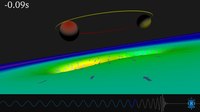
Photo from wikipedia
The detection of binary black hole coalescences by LIGO and Virgo has aroused the interest in primordial black holes (PBHs), because they could be both the progenitors of these black… Click to show full abstract
The detection of binary black hole coalescences by LIGO and Virgo has aroused the interest in primordial black holes (PBHs), because they could be both the progenitors of these black holes and a compelling candidate of dark matter (DM). PBHs are formed soon after the enhanced scalar perturbations reenter horizon during the radiation dominated era, which would inevitably induce gravitational waves as well. Searching for such scalar induced gravitational waves (SIGWs) provides an elegant way to probe PBHs. We perform the first direct search for the signals of SIGWs accompanying the formation of PBHs in the North American Nanohertz Observatory for Gravitational waves (NANOGrav) 11-year dataset. No statistically significant detection has been made, and hence we place a stringent upper limit on the abundance of PBHs at 95% confidence level. In particular, less than one part in a million of the total DM mass could come from PBHs in the mass range of [2×10^{-3},7×10^{-1}] M_{⊙}.
Journal Title: Physical review letters
Year Published: 2020
Link to full text (if available)
Share on Social Media: Sign Up to like & get
recommendations!